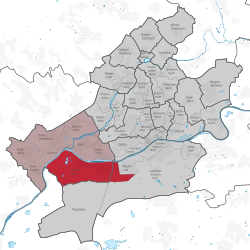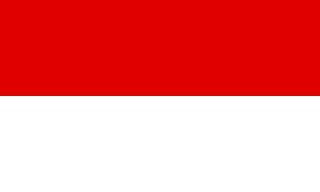
Hesse or Hessia, officially the State of Hesse, is a state in Germany. Its capital city is Wiesbaden, and the largest urban area is Frankfurt, which is also the country's principal financial centre. Two other major historic cities are Darmstadt and Kassel. With an area of 21,114.73 square kilometers and a population of over six million, it ranks seventh and fifth, respectively, among the sixteen German states. Frankfurt Rhine-Main, Germany's second-largest metropolitan area, is mainly located in Hesse.

Wiesbaden is the capital of the German state of Hesse, and the second-largest Hessian city after Frankfurt am Main. With around 283,000 inhabitants, it is Germany's 24th-largest city. Wiesbaden forms a conurbation with a population of around 500,000 with the neighbouring city of Mainz. This conurbation is in turn embedded in the Rhine-Main Metropolitan Region—Germany's second-largest metropolitan region after Rhine-Ruhr—which also includes the nearby cities of Frankfurt am Main, Darmstadt, Offenbach am Main, and Hanau, and has a combined population exceeding 5.8 million.

This article is about the history of Hesse. Hesse is a state in Germany.
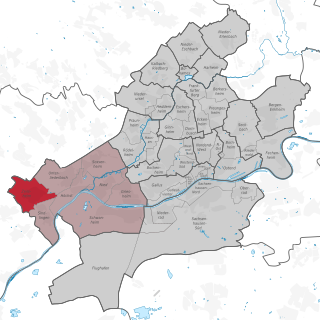
Zeilsheim is a quarter of Frankfurt am Main, Germany. It is part of the Ortsbezirk West and is subdivided into the Stadtbezirke Zeilsheim-Ost, Zeilsheim-Süd and Zeilsheim-Nord.

Lahnstein is a verband-free town of Rhein-Lahn-Kreis in Rhineland-Palatinate, Germany. It is situated at the confluence of the Lahn with the Rhine, approximately 6 kilometres (3.7 mi) south of Koblenz. Lahnstein was created in 1969 by the merger of the previously independent towns of Oberlahnstein on the south side of the Lahn and Niederlahnstein on the north side. In 2020, it had a population of 18,030.

The Grand Duchy of Hesse and by Rhine was a grand duchy in western Germany that existed from 1806 to 1918. The grand duchy originally formed from the Landgraviate of Hesse-Darmstadt in 1806 as the Grand Duchy of Hesse. It assumed the name Hesse und bei Rhein in 1816 to distinguish itself from the Electorate of Hesse, which had formed from neighbouring Hesse-Kassel. Colloquially, the grand duchy continued to be known by its former name of Hesse-Darmstadt.
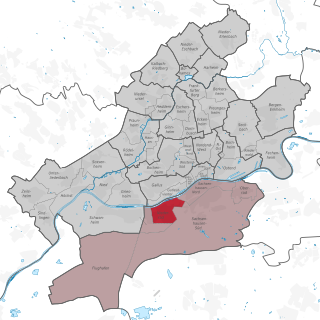
Niederrad is a quarter of Frankfurt am Main, Germany. It is part of the Ortsbezirk Süd and is subdivided into the Stadtbezirke Niederrad-Nord, Niederrad-Süd and the new Niederrad-West.
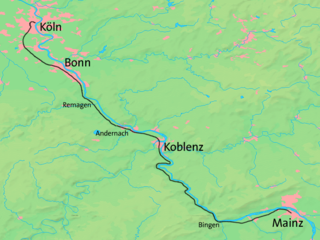
The West Rhine railway is a famously picturesque, double-track electrified railway line running for 185 km from Cologne via Bonn, Koblenz, and Bingen to Mainz. It is situated close to the western (left) bank of the river Rhine and mostly aligned to allow 160 km/h operation between Cologne and Koblenz and between Bingen and Mainz. Line speed between Koblenz and Bingen is restricted by the meandering nature of the Rhine Gorge, a UNESCO World Heritage Site.

Vendersheim is an Ortsgemeinde – a municipality belonging to a Verbandsgemeinde, a kind of collective municipality – in the Alzey-Worms district in Rhineland-Palatinate, Germany.

The Taunus Railway is a double-track electrified railway line, which connects Frankfurt and Wiesbaden, Germany. It is 41.2 km long and follows the course of the Main on its north side, running quite close to it in some places. Its first stage was opened in September 1839 and is thus the oldest railway line in the German state of Hesse and one of the oldest in Germany. Today it is used by Regional-Express trains between Frankfurt and Wiesbaden and the trains of line S1 of the Rhine-Main S-Bahn between Frankfurt-Höchst and Wiesbaden. Between Frankfurt Hbf and Frankfurt-Höchst, they run on the line of the former Hessian Ludwig Railway.
The Main Railway is a 37.5 km-long double-track electrified railway line, which runs on the south side of the river Main from Mainz to Frankfurt central station.

The S1 service of the S-Bahn Rhein-Main system bearing the KBS number 645.1 is an important railway connection running east–west. It operates between the Hesse state capital Wiesbaden and the southern Offenbach rural district serving the densely populated area along the Main river.
The Frankfurt Airport loop is a 15.8-kilometre-long (9.8 mi) double-track railway line connecting Frankfurt and Frankfurt Airport and operated as part of the Frankfurt S-Bahn. It is electrified at 15 kV/16.7 Hz.

Frankfurt am Main Stadion station is a junction railway station in Frankfurt, Germany.

Frankfurt-Niederrad station is a station in the district of Niederrad in the southwest of Frankfurt am Main in the German state of Hesse.

The Mainz bypass railway is a bypass around the Mainz Hauptbahnhof node primarily used for freight in the German states of Hesse and Rhineland Palatinate.

Frankfurt-Griesheim station is a railway station located in the Griesheim district of Frankfurt, Germany.
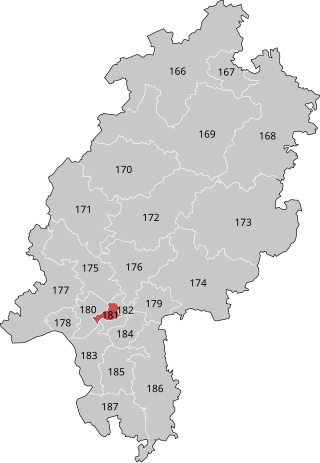
Frankfurt am Main I is an electoral constituency represented in the Bundestag. It elects one member via first-past-the-post voting. Under the current constituency numbering system, it is designated as constituency 181. It is located in southern Hesse, comprising the western part of the city of Frankfurt am Main.
The 1931–32 Eintracht Frankfurt season was the 32nd season in the club's football history. In 1931–32 the club played in the Bezirksliga Main-Hessen, then one of many top tiers of German football. It was the club's 5th season in the Bezirksliga Main-Hessen.
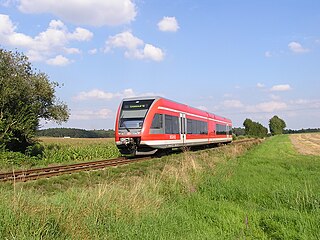
The Dreieich Railway (Dreieichbahn) is a single-track, non-electrified branch line in the Frankfurt Rhine-Main area in the German state of Hesse. It connects Dreieich-Buchschlag on the Main-Neckar Railway with Rödermark-Ober Roden on the Rodgau Railway. Colloquially, the RMV route 61 service is referred to as the Dreieichbahn, which continued beyond Ober-Roden on the Rodgau Railway to Dieburg.

